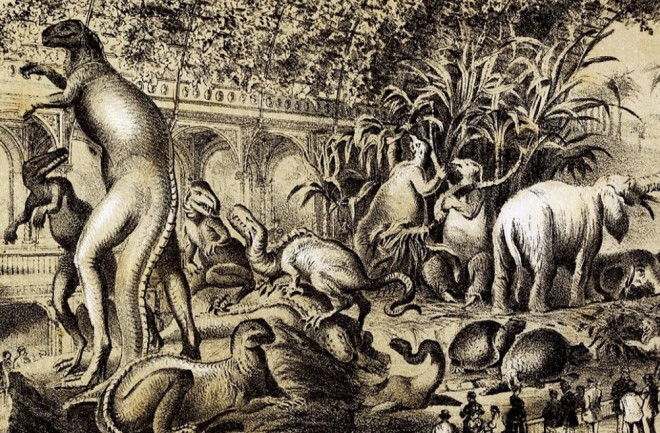The Paleozoic Museum in Central Park was sure to be spectacular. The 1868 plans for the museum imagined an immense and sophisticated space filled with fanciful dioramas of dinosaurs and other ancient animals, all intended to incite a passion for paleontology in its visitors.
But in May 1871, the models that were made for the museum were destroyed by a band of sledgehammer-wielding workmen. The incident was one of the most strange and startling moments in the history of paleontology. And as the smashed pieces of the models were swept away after the destruction, so too, were any and all lingering hopes for the city’s monument to ancient life.
For years, researchers thought they knew who orchestrated the destruction. But a paper published by the U.K. Geologists' Association rethinks the history of this incident and identifies its true culprit as the treasurer of Central Park’s Board of Commissioners, an affluent and bizarre individual by the name of Henry Hilton.
The Dinosaur Museum in New York
The desire for a grand public park was widespread among New Yorkers in the 1800s, and after years of discussion, development and landscaping, Central Park was opened in 1858. Intended as much more than a patch of greenery amidst a bustling metropolis, the park was planned to educate and entertain its visitors. An assortment of attractions were planned as additions to the park for after its opening.
One of these attractions was supposed to be a display of the ancient animals that once roamed the North American terrain, represented in finely sculpted, full-sized models. But three years after the development of the so-called Paleozoic Museum began, armed vandals arrived at the workshop where the models were being built and destroyed them, smashing all seven of the finished figures into smithereens.
Read More: How Do Scientists Reconstruct What Dinosaurs Looked Like?
The False Dino Destroyer
For decades, researchers thought that the destruction was arranged by the corrupt politician, William ‘Boss’ Tweed.
By 1870, Tweed had taken control of the city and had appointed his henchmen to positions of power in various city departments, including the Department of Public Parks. Through this department, Tweed and his helpers cancelled the plans for the Paleozoic Museum, at least partially on the basis of its cost. In fact, the project had been mostly abandoned by the time the vandals destroyed the models in the spring of 1871.
“Previous accounts of the incident had always reported that this was done under the personal instruction of ‘Boss’ Tweed himself, for various motives from raging that the display would be blasphemous to vengeance for a perceived criticism of him in a New York Times report of the project’s cancellation,” says Michael Benton, a paper author and a professor of paleontology at the University of Bristol, according to a press release.
But according to the researchers, something about that traditional explanation was suspicious.
“Reading these reports, something didn’t look right,” says Victoria Coules, another paper author and an art history student at the University of Bristol, according to the same release. “At the time, Tweed was fighting for his political life, already accused of corruption and financial wrong-doings, so why was he so involved in a museum project?”
Returning to the reports of Central Park’s Board of Commissioners, the researchers revealed that the true villain behind the vandalism was someone else entirely. “We went back to the original sources and found that it wasn't Tweed — and the motive was not blasphemy or hurt vanity,” Coules adds, according to the release.
The True Dino Destroyer
According to the researchers, Central Park’s Board of Commissioners determined on May 2 that the workshop that contained the models would be “removed.” The workshop was then destroyed the next day, on May 3, under the direct “‘direction’” of Henry Hilton, the treasurer of the board.
While Hilton was not under the influence of Tweed, the researchers found that the treasurer was interested in an alternative project at the park, the American Museum of Natural History. Not only that, but Hilton was also notorious for his odd and destructive decisions regarding art and scientific artifacts, ordering statues and skeletons that were associated with the park to be painted white on numerous occasions.
“This might seem like a local act of thuggery, but correcting the record is hugely important in our understanding of the history of paleontology,” Benton adds, according to the release. “We show it wasn’t blasphemy, or an act of petty vengeance by William Tweed, but the act of a very strange individual who made equally bizarre decisions about how artifacts should be treated.”
Read More: The First Ever Dinosaur Discovery: The Megalosaurus

